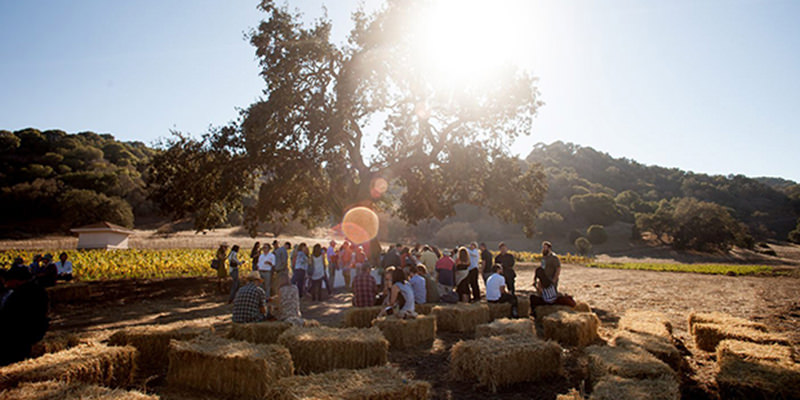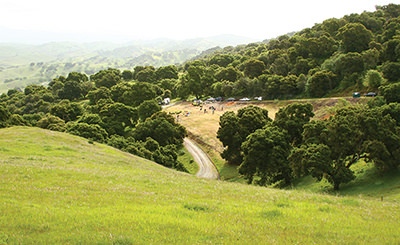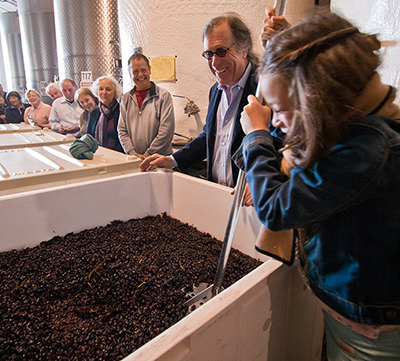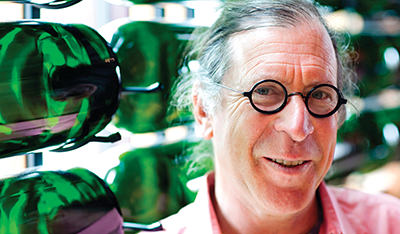
Other winemakers respect him. Wine drinkers of all levels know his brands. Journalists love him. But winemaker Randall Grahm of Bonny Doon Vineyard doesn’t need any of it.
After more than 40 years in the industry, Graham has maintained his reputation for breaking the mold. He talks like a philosopher with the soul of a scientist, but it’s just as likely that we’ve got the two mixed up. He’s chased the perfect Pinot Noir, held the 27th largest wine company in the U.S. (which is a really big deal), and advocated for the use of Rhône varietal grapes in California. The last one, along with his reputation for going against the grain, earned him the nickname “The Rhône Ranger.”
These days, he’s riding a different horse. Now well into his 60s, Grahm’s newest project veers even farther away from mainstream wine production than anything up to this point. Usually, winemakers in California purchase rootstock from a specific type of grape vine from Europe. They then graft it onto existing vines, and cultivate the grapes.
The world doesn’t need a copy of something, what the world needs is something original.
The goal for most California winemakers is to make wines that taste like the essential Pinot Noir or Syrah or Grenache. Working within these constraints brought Grahm to the realization that “essentially all the efforts to replicate a varietal wine in the New World are essentially doomed – or Dooned, if you will – to a kind of mediocrity or me-too-ness or derivativeness,” he says. “They’re essentially good or flawed facsimiles of an Old World paradigm that already exists in a more perfected form.”
So what does Europe do differently? Because the different types of grapes originate in wine growing regions, they strive to cultivate subtle differences in flavor that stem from the soil. “[European winemakers] can produce a wine of incredible depth and complexity and nuance that is very satisfying to consume and experience,” he says. “They’ve had centuries of iteration and observation and refinement.”
The Project
Instead of focusing on creating a great wine through sheer force of will (a vin d’effort, as the French would say), he wants to create a wine of place (vin de terroir). Though some winemakers argue that every wine that’s made in California has terroir, Grahm disagrees. “It’s all about discovering the strange nuanced qualities that make this place distinctive. It’s trying to figure out what this place has to say,” he says.
“The world doesn’t need a copy of something,” he says. “What the world needs is something original.” His canvas for the search for a truly unique wine is Popelouchum, a 280-acre stretch of rugged, beautiful land outside San Juan Bautista, CA. Even though the site gets less than 13 inches of rain annually, to Grahm, it seemed perfect.

Pronounced “poh-puh-lou-shoom,” the name was given to the land by the Ohlone natives. Its secondary meaning, “paradise,” is exactly what Grahm sees. “The Native Americans and a number of other indigenous peoples believed that places have a soul and a unique history and story to tell,” he says. “This whole exercise is an attempt to try to find out what this place has to say.”
To do so, he’s trying to create a wine that captures the spirit of Popelouchum – lack of water and all. As part of the project, he’ll be crossbreeding 10,000 new strains of grapes to test at Popelouchum. Though he chose the number at random – and hasn’t settled on a method to produce the grapes varietals – this step of the process alone will take several decades to complete. “I don’t have an infinite number of years ahead of me to see this project to fruition,” he says. “Time is definitely of the essence.”
This step will face challenges at both ends: what each parent plant contributes to the offspring is still largely unknown. Once the strains are bred, they’ll be planted as seeds, which is much more difficult than grafting rootstock.
After they’re planted, there’s no guarantee that they’ll survive. If they do, there’s no guarantee that they’ll make good wines. In Grahm’s words, the process is “more art than science.” Though the outcome may be “a completely new, weird, strange wine that never existed before,” it would only be a byproduct of the larger goal.
It’s really thinking of the farm as a complete organism and working on activities that make the farm as close to a closed system as you can so you don’t have to bring in external inputs or minimize your external inputs.
With some predictions for the California drought warning that it’ll just get worse, Grahm is trying to create grapes that are resistant to drought and Pierce’s disease. Since they’ll be cultivated without irrigation on land that gets very little rainfall, the grapes that survive may provide a valuable resource for future vintners.
“We’re attempting to identify and create truly more sustainable grape varieties for the future from the standpoint of disease resistance, drought tolerance, heat tolerance,” he says. “We’re also attempting to just create a more sustainable model for the future.”
The Approach
Part of the model is finding novel (or really old) ways to reduce the amount of water needed to farm. His choice to farm without irrigation, a centuries-old practice known as dry farming, is part of his attempt to farm the grapes “in such a way that you can transmit a strong sense of the soil characteristics.” This technique is widely practiced – and in some places, legally required–for growing wine grapes in Europe.
“You don’t want to drip irrigate the vineyard because that leads to less of an expression of soil characteristics,” he says. “Anything that encourages a vibrant soil ecology seems to be an amplifier of terroir. The various microflora and symbiotic fungi in the roots bring the micronutrient into the plants and sort of intensify the soil characteristics.”
I’m not sure if the light’s totally gone on or if it’s folly or a totally delusional system that I’ve begun to subscribe to.
Along with dry farming, Grahm’s approach to growing grapes at Popelouchum is a blend of modern and traditional techniques. It’s his hope that finding the right combination of agricultural techniques will provide a roadmap of sorts for winemakers working in drought conditions. “Because dry-farming/minimal irrigation limits crop production, the model may well only work for more expensive wines or for sites where land costs are very very low or are considered sunk costs,” he says. “That doesn’t really describe a lot of California.”
To preserve water, he’ll use a new natural soil additive called biochar. “Biochar is essentially activated charcoal mixed with compost and allowed to cure or get conditioned over some period of time,” says Grahm. After it’s mixed into the soil, it enhances water retention capacity by as much as 35 percent, seems to increase the shelf life of produce, and may absorb atmospheric carbon dioxide for several thousand years.

He’s also incorporating some aspects of biodynamics, a school of thought that “can be thought of as being viticultural or agricultural homeopathy,” he says. One part of this practice is the biodynamic calendar, or the belief that different parts of the plant are active at different times. Another is biodynamic preparations, which include the application of small amounts of material that are sprayed on the plant or ground “to essentially stimulate or wake up the plants,” he says.
The last element is the most philosophical. “It’s really thinking of the farm as a complete organism,” he says, “and working on activities that make the farm as close to a closed system as you can so you don’t have to bring in external inputs or minimize your external inputs.”
Many other parts of the project have the same blend of old- and new school. Earlier this year, Grahm mounted a successful Indiegogo campaign to raise a first wave of funding. Despite its success, he intends to eventually incorporate Popelouchum as a nonprofit. “I think that’s going to be a more productive way to get the magnitude of funds needed for the implementation of the project,” he says.
Legacy
“As we say, this whole thing is easier said than Doon,” he says. “Again, I’m not sure if the light’s totally gone on or if it’s folly or a totally delusional system that I’ve begun to subscribe to.”

Jim Clendenen, a friend of Grahm’s and the mind behind Au Bon Climat, believes that what Grahm is ultimately striving for within this project is an enduring legacy. “In the long-term, it could be a very valuable thing,” says Clendenen. “I don’t know what he’s going to get. That will be very interesting to see. He’s obviously thrilled by the idea, and that’s what makes it a thrilling idea.”
“I think [Popelouchum] will occupy him for the rest of his life,” says Clendenen. “It’s as viable as he believes it to be. The chances of him being successful in a project like this [are] certainly better than anybody else’s.”
